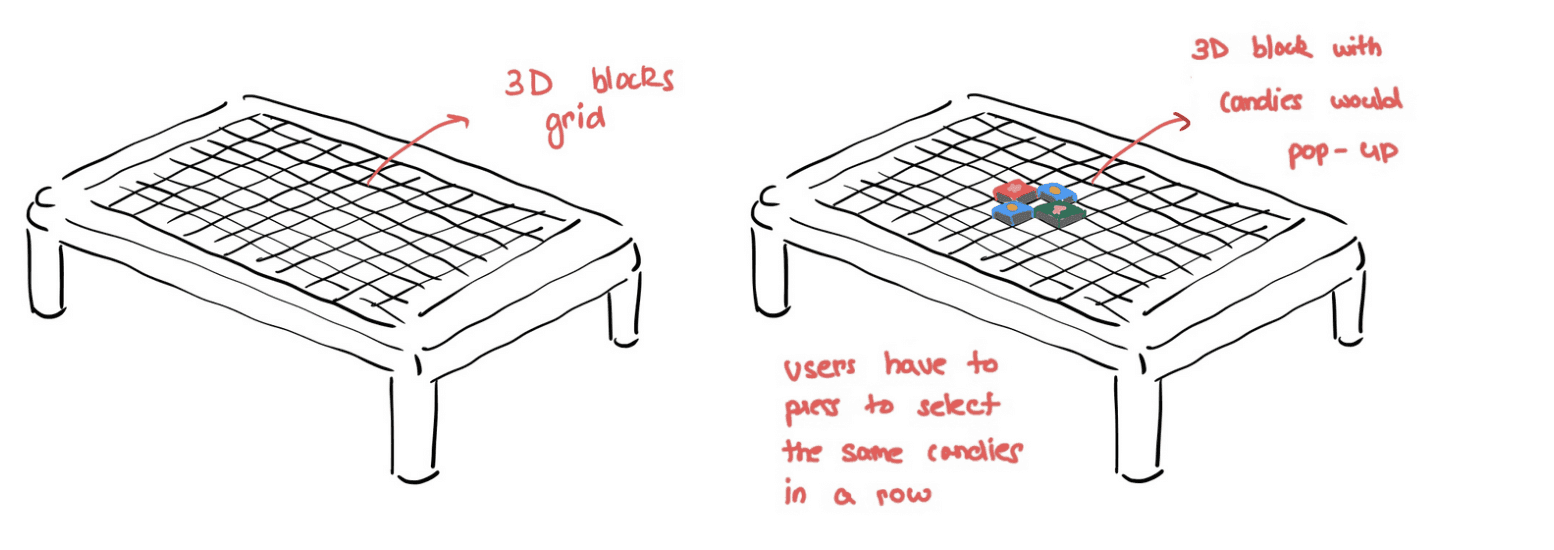Candy Crush Saga Overview
Traditionally a “match three” game, Candy Crush involves swapping adjacent candies on a board to align three or more candies of the same color. This study explores the potential of playing the game beyond mobile devices by employing three innovative interfaces: wearable, tangible, and shareable.
1. Wearable Interface: The iWatch Gaming Experience
What is a wearable interface? A wearable interface/computer is any small technological device capable of storing and processing data that can be worn on the body.
We picked an iWatch over other smart watches because it offers users an excellent mini-smartphone gaming experience. Among the many games that existed for iWatch, Rules! Was the one that used the iWatch screen as the input for the users. Below mentioned are the screens of Rules!

Imagine playing Candy Crush on your iWatch, making the most of moments when you’re just a flick of the wrist away from your next game session. The concept involves a miniaturized game interface adapted to the compact screen of an iWatch, providing an engaging gameplay experience with the convenience of wearable technology.
Design and Implementation:
For candy crush to work on iWatch, the level of difficulty of each level has to be maintained in a small screen area.
In order to change interfaces for each level, users can use the side slide button that is located on the left side of the watch. How the difficulty levels might be controlled for an iWatch is shown in the drawing below.
The first few levels would be short and easily fit on the screen, but for the later, more difficult levels, players would need to use the side button to scroll down and expand the game's bottom half in order to finish the level.

Target Audience: People aged 18 to 40, People who are familiar with touchscreen technology, Individuals who don't want to use their phones too much.
Hypothetical Scenario: The phone's battery suddenly died, and the user is in the middle of a lengthy metro ride. On his wrist, would be able to play a quick game of Candy Crush to pass the time and have some fun. It is easy, accessible, and fun to play.
2. Tangible Interface: Bringing Candies to Life
What is a tangible interface? Tangible interfaces require physical objects to manipulate the digital screens. Games like monopoly and snakes and ladders can be easily converted and played in a tangible interface.
Candy Crush, unlike Monopoly, is a game with multiple pieces (Candies) in it. For this, we would want a large digital display with several 3D blocks that users might press in order to line up the candies. How the table would appear is shown in the image above.
Transforming Candy Crush into a tangible interface meant players could physically interact with the game elements. We envisioned a large digital display with touch-responsive 3D candy blocks that players could manipulate to match and clear.
Design and Implementation:
The game's building pieces would either be digitalized screens or overhead projections of screens, and the size of the play area would change with each level. The diagram below would clarify things.
The game's rules must be adjusted so that instead of dragging candies to form a line of identical candies, players must press the candy blocks that are already aligned and push the block.
The game may have limited levels since the board can only be built with particular dimensions that users may easily reach without moving and leaving their original position.

Target Audience: Kids and Teens aged 10-22, Kids who are familiar with arcade games, Kids who enjoy playing games where they can touch and press buttons.
Hypothetical Scenario: A bunch of kids are tired of playing outdated arcade games. They had played candy crush on their phones but had never considered playing it via pushing buttons. Tracey, a 12-year-old girl, discovers a candy crush arcade where she can play the same game by pushing buttons. She is thrilled with her new experience.
3. Shareable Interface: Multiplayer Candy Matchin
What is a shareable interface? Tangible interfaces require physical objects to manipulate the digital screens. Games like monopoly and snakes and ladders can be easily converted and played in a tangible interface.
Candy Crush, unlike Monopoly, is a game with multiple pieces (Candies) in it. For this, we would want a large digital display with several 3D blocks that users might press in order to line up the candies. How the table would appear is shown in the image above.
The shareable interface allows multiple players to engage with Candy Crush simultaneously, much like playing air hockey. Each player has their own section of a large, communal screen, turning the game into a social event where players can challenge each other.
Design and Implementation:
The game has to be changed into a multiplayer game with time limits so that players may compete against one another.
At the end, the game must identify a winner and award them with more chances to earn additional points or candy points.
The interface must be created with a mirror image facing the other direction. The players would face each other while facing the polar opposites of the table.

Target Audience: People aged 18 to 40, People who are familiar with touchscreen technology, Individuals who work in creative offices and require a quick break.
Hypothetical Scenario: Socializing in offices has been difficult since the pandemic. Users' social engagement would grow if an enjoyable, shared game where they could compete with one another was introduced. Former remote worker Andy enjoyed playing the shared Candy Crush game at work and made a new friend.
Conclusion
Reimagining Candy Crush for wearable, tangible, and shareable interfaces opens up new avenues for gameplay innovation. These adaptations not only cater to different user preferences but also enhance the social and interactive aspects of gaming. By stepping beyond the mobile screen, Candy Crush can offer even more delightful and engaging experiences to its vast global community.
